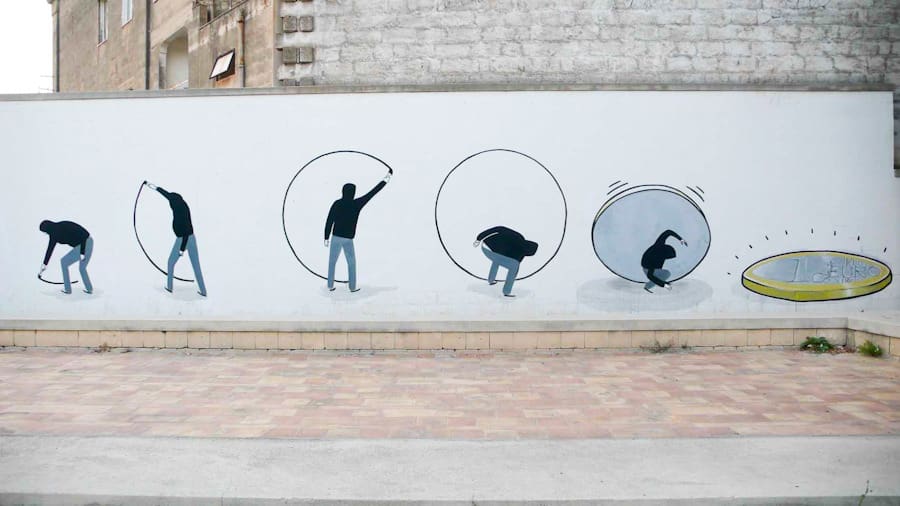AntiNote: Examples of Temporary Autonomous Zones are multifarious, and there is one nearby, closer than you think, wherever (and whenever) you are.
Pirate Utopias
by Hakim Bey (1985)
The sea-rovers and corsairs of the eighteenth century created an “information network” that spanned the globe: primitive and devoted primarily to grim business, the net nevertheless functioned admirably.
Scattered throughout the net were islands, remote hideouts where ships could be watered and provisioned, booty traded for luxuries and necessities. Some of these islands supported “intentional communities,” whole mini-societies living consciously outside the law and determined to keep it up, even if only for a short but merry life.
Some years ago I looked through a lot of secondary material on piracy hoping to find a study of these enclaves—but it appeared as if no historian has yet found them worthy of analysis (William Burroughs has mentioned the subject, as did the late British anarchist Larry Law—but no systematic research has been carried out). I retreated to primary sources and constructed my own theory, some aspects of which will be discussed in this essay. I called the settlements “Pirate Utopias.”
Recently Bruce Sterling, one of the leading exponents of Cyberpunk science fiction, published a near-future romance based on the assumption that the decay of political systems will lead to a decentralized proliferation of experiments in living: giant worker-owned corporations, independent enclaves devoted to “data piracy,” Green-Social-Democrat enclaves, Zerowork enclaves, anarchist liberated zones, etc. The information economy which supports this diversity is called the Net; the enclaves (and the book’s title) are Islands in the Net.
The medieval Assassins founded a “State” which consisted of a network of remote mountain valleys and castles, separated by thousands of miles, strategically invulnerable to invasion, connected by the information flow of secret agents, at war with all governments, and devoted only to knowledge. Modern technology, culminating in the spy satellite, makes this kind of autonomy a romantic dream. No more pirate islands! In the future the same technology—freed from all political control—could make possible an entire world of autonomous zones. But for now the concept remains precisely science fiction—pure speculation.

Are we who live in the present doomed never to experience autonomy, never to stand for one moment on a bit of land ruled only by freedom? Are we reduced either to nostalgia for the past or nostalgia for the future? Must we wait until the entire world is freed of political control before even one of us can claim to know freedom? Logic and emotion unite to condemn such a supposition. Reason demands that one cannot struggle for what one does not know; and the heart revolts at a universe so cruel as to visit such injustices on our generation alone of humankind.
To say that “I will not be free till all humans (or all sentient creatures) are free” is simply to cave in to a kind of nirvana-stupor, to abdicate our humanity, to define ourselves as losers.
I believe that by extrapolating from past and future stories about “islands in the net” we may collect evidence to suggest that a certain kind of “free enclave” is not only possible in our time but also existent. All my research and speculation has crystallized around the concept of the TEMPORARY AUTONOMOUS ZONE (hereafter abbreviated TAZ). Despite its synthesizing force for my own thinking, however, I don’t intend the TAZ to be taken as more than an essay (“attempt”), a suggestion, almost a poetic fancy. Despite the occasional Ranterish enthusiasm of my language I am not trying to construct political dogma. In fact I have deliberately refrained from defining the TAZ–I circle around the subject, firing off exploratory beams. In the end the TAZ is almost self-explanatory. If the phrase became current it would be understood without difficulty…understood in action.
The TAZ is like an uprising which does not engage directly with the State, a guerrilla operation which liberates an area (of land, of time, of imagination) and then dissolves itself to re-form elsewhere/elsewhen, before the State can crush it. Because the State is concerned primarily with Simulation rather than substance, the TAZ can “occupy” these areas clandestinely and carry on its festal purposes for quite a while in relative peace. Perhaps certain small TAZs have lasted whole lifetimes because they went unnoticed, like hillbilly enclaves—because they never intersected with the Spectacle, never appeared outside that real life which is invisible to the agents of Simulation.

Babylon takes its abstractions for realities; precisely within this margin of error the TAZ can come into existence. Getting the TAZ started may involve tactics of violence and defense, but its greatest strength lies in its invisibility—the State cannot recognize it because History has no definition of it. As soon as the TAZ is named (represented, mediated), it must vanish, it will vanish, leaving behind it an empty husk, only to spring up again somewhere else, once again invisible because undefinable in terms of the Spectacle.
The TAZ is thus a perfect tactic for an era in which the State is omnipresent and all-powerful and yet simultaneously riddled with cracks and vacancies. And because the TAZ is a microcosm of that “anarchist dream” of a free culture, I can think of no better tactic by which to work toward that goal while at the same time experiencing some of its benefits here and now.
The TAZ is an encampment of guerrilla ontologists: strike and run away. Keep moving the entire tribe, even if it’s only data in the Web. The TAZ must be capable of defense; but both the “strike” and the “defense” should, if possible, evade the violence of the State, which is no longer a meaningful violence. The strike is made at structures of control, essentially at ideas; the defense is “invisibility,” a martial art, and “invulnerability”—an “occult” art within the martial arts. The “nomadic war machine” conquers without being noticed and moves on before the map can be adjusted. As to the future—only the autonomous can plan autonomy, organize for it, create it. It’s a bootstrap operation. The first step is somewhat akin to satori—the realization that the TAZ begins with a simple act of realization.

The media invite us to “come celebrate the moments of your life” with the spurious unification of commodity and spectacle, the famous non-event of pure representation. In response to this obscenity we have, on the one hand, the spectrum of refusal (chronicled by the Situationists, John Zerzan, Bob Black et al.)—and on the other hand, the emergence of a festal culture removed and even hidden from the would-be managers of our leisure. “Fight for the right to party” is in fact not a parody of the radical struggle but a new manifestation of it, appropriate to an age which offers TVs and telephones as ways to “reach out and touch” other human beings, ways to “Be There!”
The sixties-style “tribal gathering,” the forest conclave of eco-saboteurs, the idyllic Beltane of the neo-pagans, anarchist conferences, gay faery circles…Harlem rent parties of the twenties, nightclubs, banquets, old-time libertarian picnics—we should realize that all these are already “liberated zones” of a sort, or at least potential TAZs. Whether open only to a few friends, like a dinner party, or to thousands of celebrants, like a Be-In, the party is always “open” because it is not “ordered”; it may be planned, but unless it “happens” it’s a failure. The element of spontaneity is crucial.

The essence of the party: face-to-face, a group of humans synergize their efforts to realize mutual desires, whether for good food and cheer, dance, conversation, the arts of life; perhaps even for erotic pleasure, or to create a communal artwork, or to attain the very transport of bliss—in short, a “union of egoists” (as Stirner put it) in its simplest form—or else, in Kropotkin’s terms, a basic biological drive to “mutual aid.” (Here we should also mention Bataille’s “economy of excess” and his theory of potlatch culture.)
We’ve spoken of the Net, which can be defined as the totality of all information and communication transfer. Some of these transfers are privileged and limited to various elites, which gives the Net a hierarchic aspect. Other transactions are open to all—so the Net has a horizontal or non-hierarchic aspect as well. Military and Intelligence data are restricted, as are banking and currency information and the like. But for the most part the telephone, the postal system, public data banks, etc. are accessible to everyone and anyone.
Thus within the Net there has begun to emerge a shadowy sort of counter-Net, which we will call the Web (as if the Net were a fishing-net and the Web were spider-webs woven through the interstices and broken sections of the Net). Generally we’ll use the term Web to refer to the alternate horizontal open structure of info-exchange, the non-hierarchic network, and reserve the term counter-Net to indicate clandestine illegal and rebellious use of the Web, including actual data-piracy and other forms of leeching off the Net itself. Net, Web, and counter-Net are all parts of the same whole pattern-complex—they blur into each other at innumerable points. The terms are not meant to define areas but to suggest tendencies.
The present forms of the unofficial Web are, one must suppose, still rather primitive: the marginal zine network, the BBS networks, pirated software, hacking, phone-phreaking, some influence in print and radio, almost none in the other big media—no TV stations, no satellites, no fiber-optics, no cable, etc., etc. However the Net itself presents a pattern of changing/evolving relations between subjects (“users”) and objects (“data”). The nature of these relations has been exhaustively explored, from McLuhan to Virilio.
The TAZ has a temporary but actual location in time and a temporary but actual location in space. But clearly it must also have “location” in the Web, and this location is of a different sort, not actual but virtual, not immediate but instantaneous. The Web not only provides logistical support for the TAZ, it also helps to bring it into being; crudely speaking one might say that the TAZ “exists” in information-space as well as in the “real world.”

We have noted that the TAZ, because it is temporary, must necessarily lack some of the advantages of a freedom which experiences duration and a more-or-less fixed locale. But the Web can provide a kind of substitute for some of this duration and locale—it can inform the TAZ, from its inception, with vast amounts of compacted time and space which have been “subtilized” as data.
At this moment in the evolution of the Web, and considering our demands for the “face-to-face” and the sensual, we must consider the Web primarily as a support system, capable of carrying information from one TAZ to another, of defending the TAZ, rendering it “invisible” or giving it teeth, as the situation might demand. But more than that: If the TAZ is a nomad camp, then the Web helps provide the epics, songs, genealogies and legends of the tribe; it provides the secret caravan routes and raiding trails which make up the flowlines of tribal economy; it even contains some of the very roads they will follow, some of the very dreams they will experience as signs and portents.
The Web does not depend for its existence on any computer technology. Word-of-mouth, mail, the marginal zine network, “phone trees,” and the like already suffice to construct an information webwork. The key is not the brand or level of tech involved, but the openness and horizontality of the structure.
Lay down a map of the land; over that, set a map of political change; over that, a map of the Net, especially the counter-Net with its emphasis on clandestine information-flow and logistics—and finally, over all, the 1:1 map of the creative imagination, aesthetics, values. The resultant grid comes to life, animated by unexpected eddies and surges of energy, coagulations of light, secret tunnels, surprises.

Excerpted from Hakim Bey, The Temporary Autonomous Zone: Ontological Anarchy, Poetic Terrorism (Autonomedia, 1990). Here is a .pdf of the whole thing. The complete text (which can still be read in one sitting) is rich and possibly more urgently relevant now, a quarter century later, than when it first appeared.
Featured image source: Eyes Wide Shut blog. Berlin 1981. Banner reads: “Our youth is better off occupying empty buildings than foreign countries.”
Autonomedia’s attitude toward copyright:






